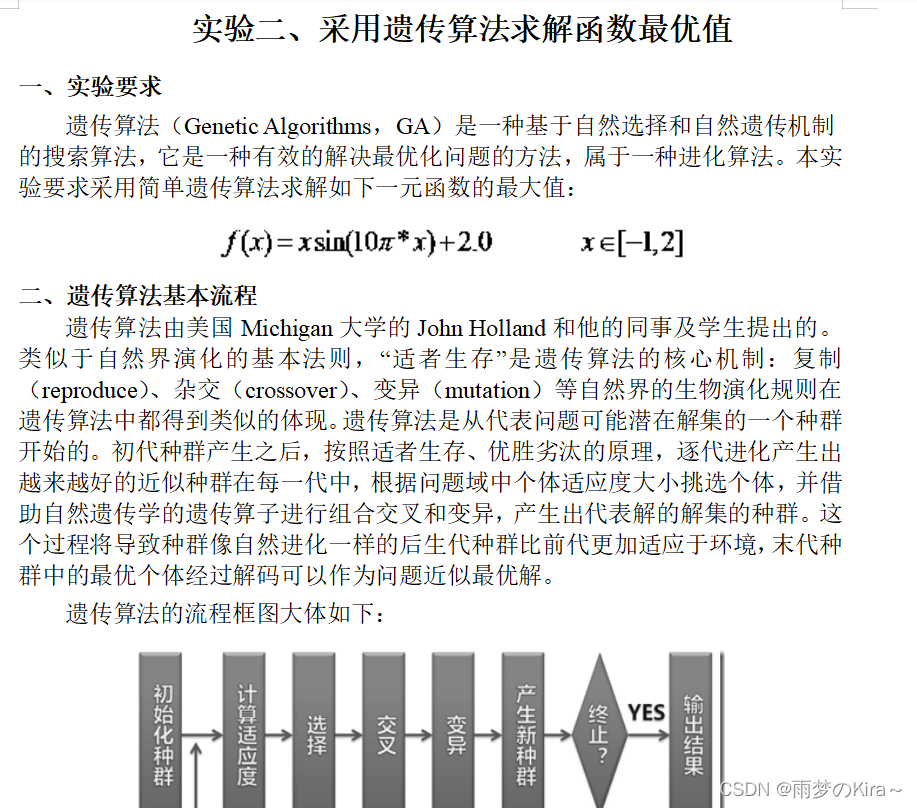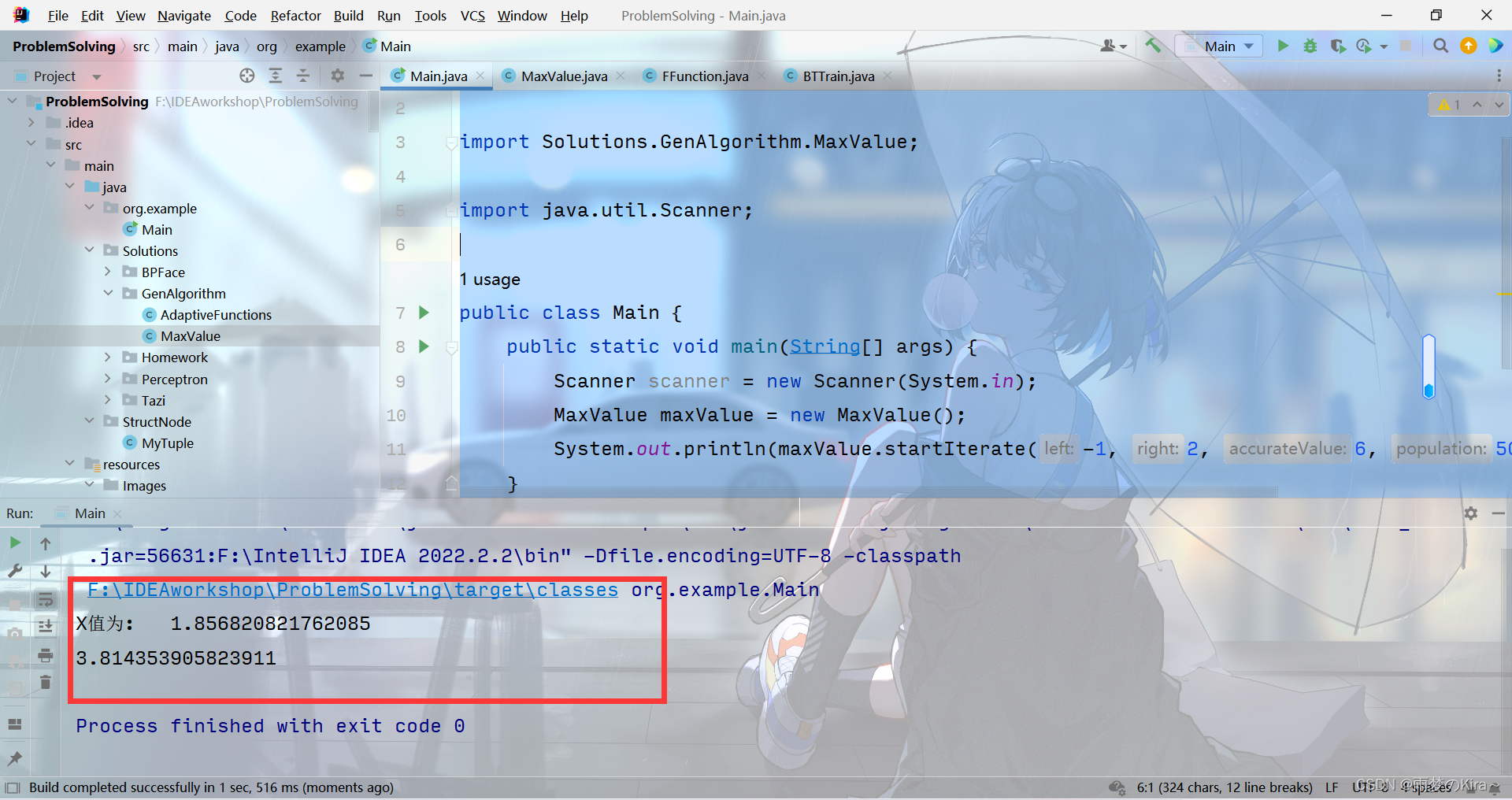XTU计网的选修课实验,任课老师为申老师。
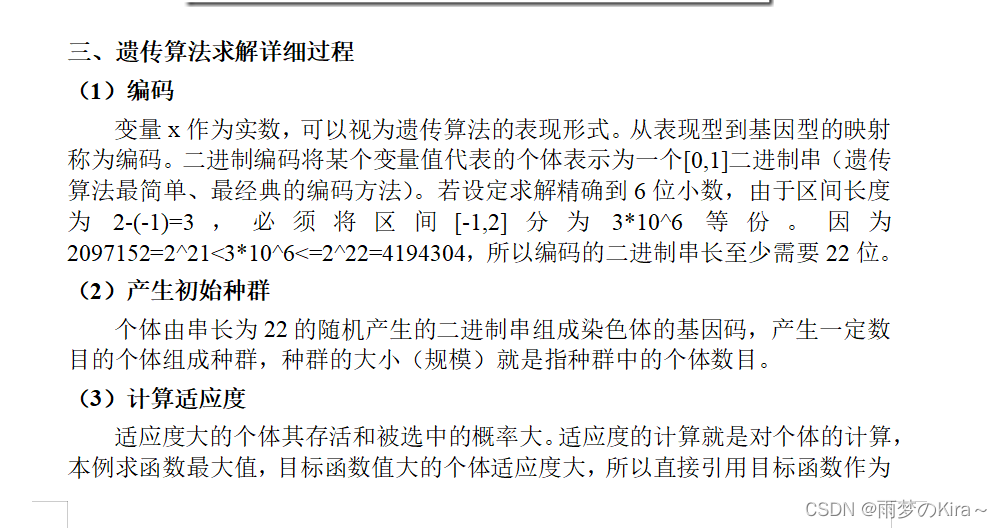
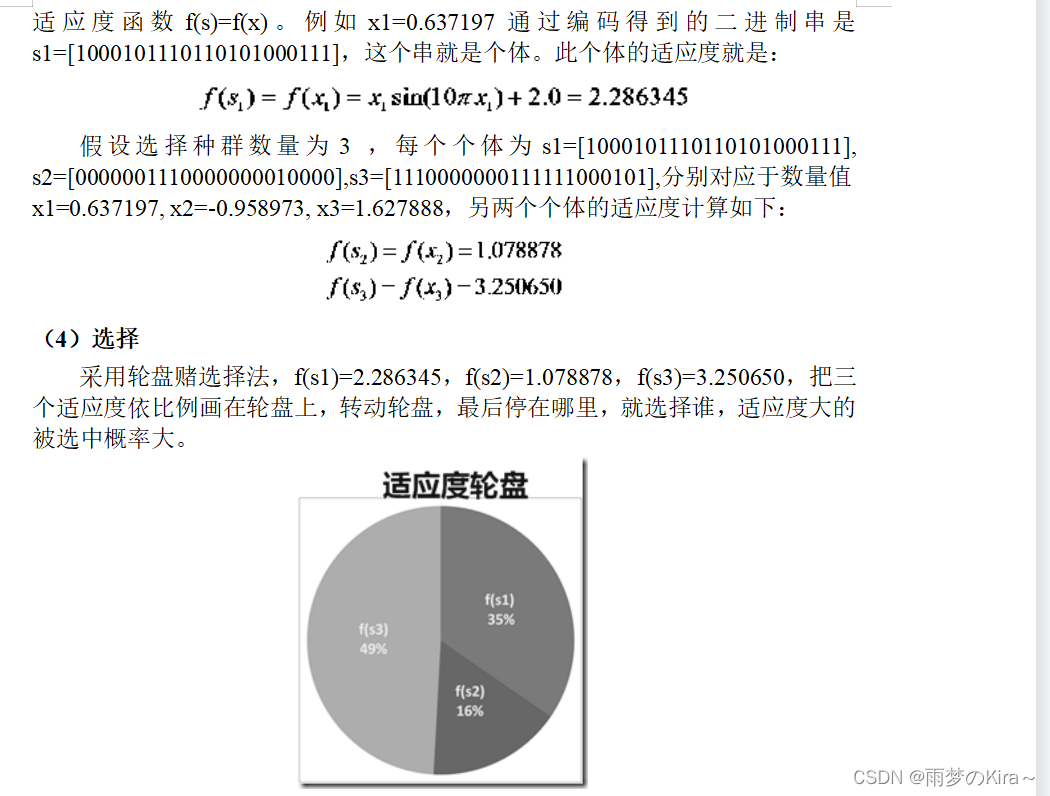
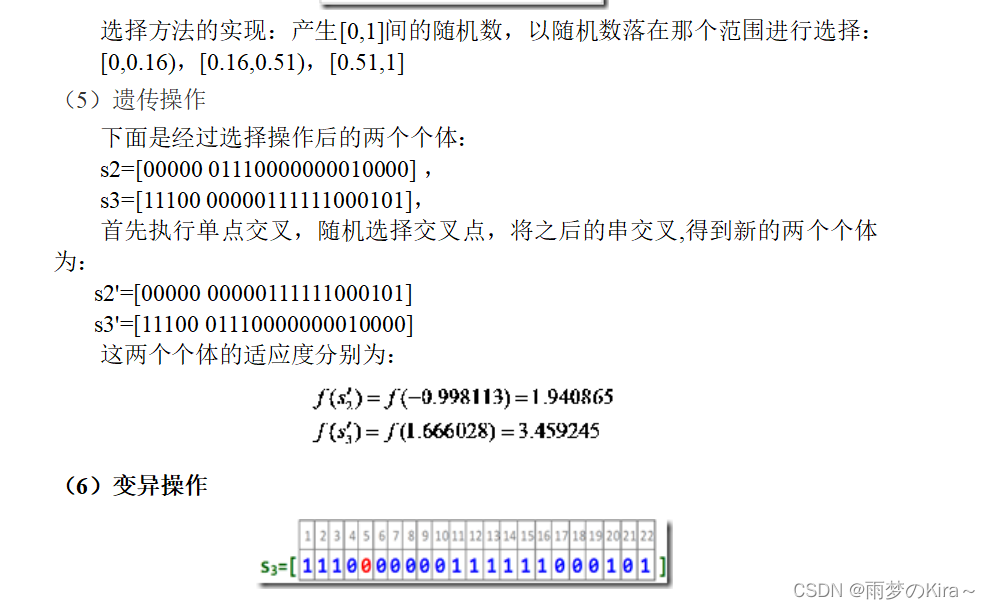
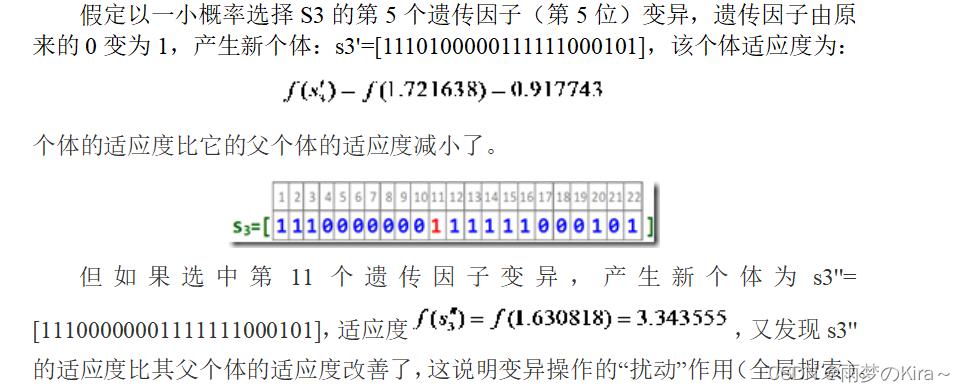
实验其实也很简单,重要的是你要跟着上述的指导书一步一步来。
定义结构体,第一个参数表示在[-1,2]里面的值,第二个则表示在群体之中的值,第三个就是适应度。
其中存在对应关系:mySpecies[i].second = (mySpecies[i].first + 1) / 3 * speciesNums;
后面就是跟着实验指导书来,没什么好说的。
唯一与实验指导书不同的是,我才用了精英选择算法,使用上一代最强的个体替换掉最弱的个体,保证种群不会退化。
关于早熟的理解:例如只有两个个体:[1,1,1,0,0], [1.0.0.1.1],我们不难看出他们的第一个都是1,无论你怎么交叉,它都是1,我们可以假设如果所有的种群在某一位相等,那么他就永远不会改变,那样就失去了交叉的意义,所以需要强制变异。
主代码如下:
package Solutions.GenAlgorithm;
import java.util.Arrays;
import java.util.Random;
public class MaxValue {
public static class MyEntity{
//first is the number of interval [left, right].
//second is the number of a representation on binary
//third is the fitness of this entity
public double first, second, third;
}
//really Species Population
private int count = 0;
public int speciesCounts = 0;
public int speciesNums = 0;
//Crossover probability
public double p = 0.7;
//Mutation probability
public double mutationProbability = 0.001;
//better species that each cycle to select
public MyEntity[] mySpecies;
//the number of a species
public int mySpeciesPopulation;
//the best Entity
public MyEntity bestEntity = new MyEntity();
//a class to reserve the function about fitness
public AdaptiveFunctions adaptiveFunctions = new AdaptiveFunctions();
//calculate Species population
public void initSpecies(int left, int right, int accurateValue){
//expected Species population
speciesNums = 0;
speciesCounts = 0;
bestEntity.third = 0;
bestEntity.first = 0;
bestEntity.second = 0;
int entityLength = (int) Math.pow(10, accurateValue) * (right - left);
int temp = 1;
do {
speciesCounts++;
temp *= 2;
} while (temp < entityLength);
speciesNums = temp;
}
//create a species
public void createSpecies(int population){
//random to create entity.
this.mySpecies = new MyEntity[population];
this.mySpeciesPopulation = population;
//the range is from left to right.
//example: if our interval is [-1,2].
//the random is [0,1], we need mul 3 and subtract 1 to get [-1,2].
for(int i = 0;i < population;i++){
mySpecies[i] = new MyEntity();
mySpecies[i].first = (Math.random() * 3) - 1;
mySpecies[i].second = (mySpecies[i].first + 1) / 3 * speciesNums;
}
}
//to calculate the fitness to select better entity
public void selectSpecies(){
int n = mySpecies.length;
double sum = 0, m = 0;
//calculate the sum of fitness.
for (var specy : mySpecies) {
specy.third = adaptiveFunctions.maxFunctions(specy.first);
sum += specy.third;
}
//to get the probability of each entity
//select better entity
MyEntity worstEntity = new MyEntity();
MyEntity[] myTempSpecies = new MyEntity[n];
for(int i = 0;i < n;i++){
double r = Math.random() * sum;
myTempSpecies[i] = new MyEntity();
double preFitnessValue = 0;
for (var mySpecy : mySpecies) {
preFitnessValue += mySpecy.third;
if (preFitnessValue >= r) {
myTempSpecies[i] = mySpecy;
break;
}
}
}
count++;
for(int i = 0;i < mySpeciesPopulation;i++){
if(mySpecies[i].third > bestEntity.third){
count = 0;
bestEntity.third = mySpecies[i].third;
bestEntity.second = mySpecies[i].second;
bestEntity.first = mySpecies[i].first;
}
}
//exchange the value
System.arraycopy(myTempSpecies, 0, mySpecies, 0, n);
}
public void crossoverSpecies(){
for(int i = 0, pre = -1;i < mySpecies.length;i++){
if(Math.random() < p){
if (pre == -1) pre = i;
else {
//start crossover
int crossoverPoint = new Random().nextInt(speciesCounts + 1);
//System.out.println(l + " " + r);
//we need 22 bit, so we use this format to get that.
StringBuilder p1 = new StringBuilder(String.format("%22s", Integer.toBinaryString((int)mySpecies[pre].second)).replace(' ', '0'));
StringBuilder p2 = new StringBuilder(String.format("%22s", Integer.toBinaryString((int)mySpecies[i].second)).replace(' ', '0'));
//from crossoverPoint to start crossover.
for(int j = crossoverPoint;j < p1.length();j++){
var sp = p1.charAt(j);
p1.setCharAt(j, p2.charAt(j));
p2.setCharAt(j, sp);
}
//change the 2 bit to 10 bit.
int num1 = Integer.parseInt(p1.toString(), 2);
int num2 = Integer.parseInt(p2.toString(), 2);
//other value also be changed synchronously
mySpecies[pre].second = num1;
mySpecies[pre].first = 3 * num1 * 1.0 / speciesNums - 1;
mySpecies[pre].third = adaptiveFunctions.maxFunctions(mySpecies[pre].first);
mySpecies[i].second = num2;
mySpecies[i].first = 3 * num2 * 1.0 / speciesNums - 1;
mySpecies[i].third = adaptiveFunctions.maxFunctions(mySpecies[i].first);
}
}
}
}
public void mutation(){
StringBuilder[] sb = new StringBuilder[mySpeciesPopulation];
for(int i = 0;i < mySpeciesPopulation;i++){
sb[i] = new StringBuilder(String.format("%22s", Integer.toBinaryString((int)mySpecies[i].second)).replace(' ', '0'));
var r = Math.random();
//start mutate
if(r < mutationProbability){
//select entity to mutate
int mutationIndex = new Random().nextInt(speciesCounts);
StringBuilder p = new StringBuilder(String.format("%22s", Integer.toBinaryString((int)mySpecies[i].second)).replace(' ', '0'));
var target = p.charAt(mutationIndex);
if(target == '0') p.setCharAt(mutationIndex, '1');
else p.setCharAt(mutationIndex, '0');
int num = Integer.parseInt(p.toString(), 2);
var m = adaptiveFunctions.maxFunctions(3 * num * 1.0 / speciesNums - 1);
mySpecies[i].second = num;
mySpecies[i].first = 3 * num * 1.0 / speciesNums - 1;
mySpecies[i].third = m;
}
}
//Prevent the entry of local optimal solutions
for(int i = 0;i < speciesCounts;i++){
boolean isSample = true;
for(int j = 1;j < mySpeciesPopulation;j++){
if(sb[j].charAt(i) != sb[j-1].charAt(i)){
isSample = false;
break;
}
}
if (isSample){
for(int k = 0;k < mySpeciesPopulation / 5;k++){
int j = new Random().nextInt(mySpeciesPopulation);
var target = sb[j].charAt(i);
if(target == '0') sb[j].setCharAt(i, '1');
else sb[j].setCharAt(i, '0');
}
//System.out.println("陷入了局部最优");
}
}
for(int i = 0;i < mySpeciesPopulation ;i++){
//System.out.println(sb[i] + " " + "Best Entity : " + " " + bestEntity.third);
int num = Integer.parseInt(sb[i].toString(), 2);
var m = adaptiveFunctions.maxFunctions(3 * num * 1.0 / speciesNums - 1);
mySpecies[i].second = num;
mySpecies[i].first = 3 * num * 1.0 / speciesNums - 1;
mySpecies[i].third = m;
}
//System.out.println("********下一代********");
}
//to find the worstEntity
private int findWorstEntity(){
double f = mySpecies[0].third;
int index = 0;
for(int i = 0;i < mySpeciesPopulation;i++){
if(mySpecies[i].third < f){
f = mySpecies[i].third;
index = i;
}
}
return index;
}
public double startIterate(int left, int right, int accurateValue, int population, int iteratingCounts){
double ans = 0, fitness = 0;
//fist we init the population.
//to seek how many counts we need.
initSpecies(left, right, accurateValue);
//then we can create the population by the former
createSpecies(population);
//start to iterator the population to find the best entity
while(iteratingCounts-- != 0){
if(this.count >= 100){
System.out.println("迭代100结束");
break;
}
selectSpecies();
crossoverSpecies();
mutation();
//use bestEntity to replace worstEntity
/*for(var species : mySpecies){
System.out.println(String.format("%22s", Integer.toBinaryString((int)species.second)).replace(' ', '0'));
}*/
int index = findWorstEntity();
mySpecies[index].first = bestEntity.first;
mySpecies[index].second = bestEntity.second;
mySpecies[index].third = bestEntity.third;
}
//we can seek the result when we finish iteration.
for(var species : mySpecies){
if(species.third > fitness){
ans = species.first;
fitness = species.third;
}
}
System.out.println("X值为:\t" + ans);
return fitness;
}
}
适应函数:
package Solutions.GenAlgorithm;
public class AdaptiveFunctions {
public double maxFunctions(double x){
return x * Math.sin(10 * Math.PI * x) + 2.0;
}
}
主函数:
package org.example;
import Solutions.GenAlgorithm.MaxValue;
import java.util.Scanner;
public class Main {
public static void main(String[] args) {
Scanner scanner = new Scanner(System.in);
MaxValue maxValue = new MaxValue();
System.out.println(maxValue.startIterate(-1, 2, 6, 50, 1));
}
}使用如下:
今天的文章遗传算法求解最大值_人工智能的算法有哪些「建议收藏」分享到此就结束了,感谢您的阅读。
版权声明:本文内容由互联网用户自发贡献,该文观点仅代表作者本人。本站仅提供信息存储空间服务,不拥有所有权,不承担相关法律责任。如发现本站有涉嫌侵权/违法违规的内容, 请发送邮件至 举报,一经查实,本站将立刻删除。
如需转载请保留出处:https://bianchenghao.cn/89106.html

